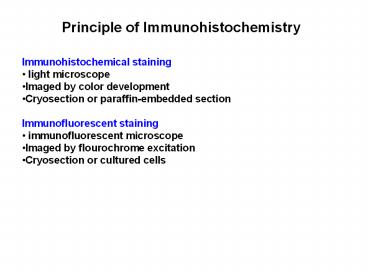Principle of Immunohistochemistry - PowerPoint PPT Presentation
1 / 23
Title:
Principle of Immunohistochemistry
Description:
Dark-field microscope It is different form the bright field one in the condenser lens function and is useful for viewing particles far below the limits of bright ... – PowerPoint PPT presentation
Number of Views:391
Avg rating:3.0/5.0
Title: Principle of Immunohistochemistry
1
Principle of Immunohistochemistry
- Immunohistochemical staining
- light microscope
- Imaged by color development
- Cryosection or paraffin-embedded section
- Immunofluorescent staining
- immunofluorescent microscope
- Imaged by flourochrome excitation
- Cryosection or cultured cells
2
J Histochem. Cytochem. 2006 54371-74
Carnoys solution
Glutaraldehyde
1day 336 days 1day
336 days
Glutaraldehyde 15.5ml 25 GA12.5ml phosphate
buffer dH20 to 100ml Carnoys solution 60ml
aboslute ETOH30ml CHCl4 10ml 100 Acetic acid
3
Effect of fixation on tissues
4 phosphate buffered formalin
FGA 28days
Mt DNA
TC11 56days
TC11 84 days
4
Effect of fixation on tissues
5
Specificity control for IHCControls for the
specificity of an antibody are most important for
the correct interpretation of its localization in
cells and tissues
- Absorption control
- antibody mixed with the protein or peptide used
to generate the antibody, with the objective of
eliminating the binding of the antibody to the
protein in the tissue - Drawback determines only the specificity of
the antibody for the incubating protein or
peptide and does not prove the specificity of the
antibody for the protein in the tissue
6
Specificity control for IHCControls for the
specificity of an antibody are most important for
the correct interpretation of its localization in
cells and tissues
- Specificity of the antibody
- 1. determined by showing specific reaction with
the peptide or protein used for immunization with
highly sensitive methods other than IHC - ? immunoblot
- ?immunoprecipitation
- 2. details of antibody generation
- sequence of amino acids used, species from
which the immunogen obtained, isotype of
immunoglobulin generated
7
Specificity control for IHCControls for the
specificity of an antibody are most important for
the correct interpretation of its localization in
cells and tissues
- Specificity of the IHC method
- 1. labeling is specifically due to the primary
antibody - ? normal serum control
- ? a known unreactive antibody control
- ? nonspecific binding control
- 2. confirmation of Ab specificity with tissues
(cells) containing the protein of interest
8
(No Transcript)
9
- Definition predominantly (originally) defined as
a high-temperature heating method to recover the
antigenicity of tissue section that had been
masked by formalin fixation - Purpose amplification in pre-detection phase by
reduction of the detection thresholds of
immunostaining (increasing sensitivity) and
retrieval of some antigens
10
- Mechanism of action
- 1. release calcium from the cage-like calcium
complex formation with proteins in formalin-fixed
tissue - 2. lossening of breaking of the crosslinkage
induced by formalin fixation
11
- Application
- paraffin-embedded section, plastic embedded
tissues, celloidin-embedded tissues, non-embedded
tissue slices, cell smear preparations, ISH,
Tunnel, FISH - Caution
- 1. not all antigen modified by formalin can be
restroed using conventional AR protocols - 2. high temperature may induce a negative result
of IHC staining - 3. pH value of the AR solution
12
Microwave Vacuum Histoprocessor
13
(No Transcript)
14
(No Transcript)
15
AR for FISH
16
Principle of Immunohistochemistry
- Immunohistochemical staining
- light microscope
- Imaged by color development
- Cryosection or paraffin-embedded section
- Immunofluorescent staining
- immunofluorescent microscope
- Imaged by flourochrome excitation
- Cryosection or cultured cells
17
Light Microscope 1. Bright-field
microscope 2. Dark-field microscope It is
different form the bright field one in the
condenser lens function and is useful for viewing
particles far below the limits of bright light
resolution by darkening the background. 3. Phase
contrast microscope With a specifically
designed condenser lens, it can be used to
examine living cells and unstained tissue by
utilizing differences in the diffraction index
of cell or tissue component. 4. Differential
interference microscope Using Normaski
optics, it is useful for surface examination of
the object. 5. Fluorescence microscope It
is equipped with an ultraviolet light source to
detect tissue autofluorescence or
fluorescence-labeled components of the tissue. 6.
Confocal scanning microscope It is designed
to combine light microscope components, fitted
with fluorescence equipment and a scanning
system, with a computer system to image the
specimen in very thin optical sections by
subtracting out-of-focus regions, and even create
an 3-D image through stacking a series of images
at varying depths. 7. Ultraviolet microscope
With UV light source, images are viewed through
photographic records rather than an ocular. 8.
Polarizing microscope It is useful for
detecting crystalline substances and well-ordered
fibrous molecules due to the result of
birefringence.
18
Phase contrast microscope
19
Differential interference microscope
20
(No Transcript)
21
Principle of Immunofluorescent microscopic
staining
22
Double immunofluorescence of Pinin and
cytokeratin
( Ouyang and Sugrue, JCB 1996)
23
Triple immunofluorescent staining of mitotic
spindle

